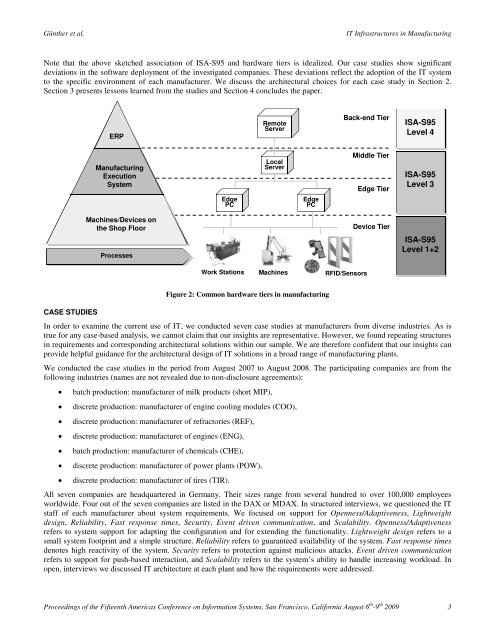IT Infrastructures in Manufacturing: Insights from Seven Case Studies
IT Infrastructures in Manufacturing: Insights from Seven Case Studies
IT Infrastructures in Manufacturing: Insights from Seven Case Studies
You also want an ePaper? Increase the reach of your titles
YUMPU automatically turns print PDFs into web optimized ePapers that Google loves.
Günther et al. <strong>IT</strong> <strong>Infrastructures</strong> <strong>in</strong> Manufactur<strong>in</strong>g<br />
Note that the above sketched association of ISA-S95 and hardware tiers is idealized. Our case studies show significant<br />
deviations <strong>in</strong> the software deployment of the <strong>in</strong>vestigated companies. These deviations reflect the adoption of the <strong>IT</strong> system<br />
to the specific environment of each manufacturer. We discuss the architectural choices for each case study <strong>in</strong> Section 2.<br />
Section 3 presents lessons learned <strong>from</strong> the studies and Section 4 concludes the paper.<br />
CASE STUDIES<br />
ERP<br />
Manufactur<strong>in</strong>g<br />
Execution<br />
System<br />
Mach<strong>in</strong>es/Devices on<br />
the Shop Floor<br />
Processes<br />
Edge<br />
PC<br />
Work Stations<br />
Remote<br />
Server<br />
Local<br />
Server<br />
Mach<strong>in</strong>es<br />
Proceed<strong>in</strong>gs of the Fifteenth Americas Conference on Information Systems, San Francisco, California August 6 th -9 th 2009 3<br />
Edge<br />
PC<br />
Figure 2: Common hardware tiers <strong>in</strong> manufactur<strong>in</strong>g<br />
Back-end Tier<br />
RFID/Sensors<br />
Middle Tier<br />
Edge Tier<br />
Device Tier<br />
ISA-S95<br />
Level 4<br />
ISA-S95<br />
Level 3<br />
ISA-S95<br />
Level 1+2<br />
In order to exam<strong>in</strong>e the current use of <strong>IT</strong>, we conducted seven case studies at manufacturers <strong>from</strong> diverse <strong>in</strong>dustries. As is<br />
true for any case-based analysis, we cannot claim that our <strong>in</strong>sights are representative. However, we found repeat<strong>in</strong>g structures<br />
<strong>in</strong> requirements and correspond<strong>in</strong>g architectural solutions with<strong>in</strong> our sample. We are therefore confident that our <strong>in</strong>sights can<br />
provide helpful guidance for the architectural design of <strong>IT</strong> solutions <strong>in</strong> a broad range of manufactur<strong>in</strong>g plants.<br />
We conducted the case studies <strong>in</strong> the period <strong>from</strong> August 2007 to August 2008. The participat<strong>in</strong>g companies are <strong>from</strong> the<br />
follow<strong>in</strong>g <strong>in</strong>dustries (names are not revealed due to non-disclosure agreements):<br />
batch production: manufacturer of milk products (short MIP),<br />
discrete production: manufacturer of eng<strong>in</strong>e cool<strong>in</strong>g modules (COO),<br />
discrete production: manufacturer of refractories (REF),<br />
discrete production: manufacturer of eng<strong>in</strong>es (ENG),<br />
batch production: manufacturer of chemicals (CHE),<br />
discrete production: manufacturer of power plants (POW),<br />
discrete production: manufacturer of tires (TIR).<br />
All seven companies are headquartered <strong>in</strong> Germany. Their sizes range <strong>from</strong> several hundred to over 100,000 employees<br />
worldwide. Four out of the seven companies are listed <strong>in</strong> the DAX or MDAX. In structured <strong>in</strong>terviews, we questioned the <strong>IT</strong><br />
staff of each manufacturer about system requirements. We focused on support for Openness/Adaptiveness, Lightweight<br />
design, Reliability, Fast response times, Security, Event driven communication, and Scalability. Openness/Adaptiveness<br />
refers to system support for adapt<strong>in</strong>g the configuration and for extend<strong>in</strong>g the functionality. Lightweight design refers to a<br />
small system footpr<strong>in</strong>t and a simple structure. Reliability refers to guaranteed availability of the system. Fast response times<br />
denotes high reactivity of the system. Security refers to protection aga<strong>in</strong>st malicious attacks. Event driven communication<br />
refers to support for push-based <strong>in</strong>teraction, and Scalability refers to the system’s ability to handle <strong>in</strong>creas<strong>in</strong>g workload. In<br />
open, <strong>in</strong>terviews we discussed <strong>IT</strong> architecture at each plant and how the requirements were addressed.





